

February 2022 Interview with Rick Hwang, President of Rugged & Video Solutions Business Group at Getac

Getac's Mighty Class of 2021
January 2021 Interview with Rick Hwang, President of Rugged & Video Solutions Business Group at Getac

Getac V110 at Cirque du Soleil

Getac 25th Anniversary at 2014 Miramar Air Show

Getac FedEx TechConnect

TDI Panamericana 2011 team using Getac V100 on 16,000 mile endurance challenge
|

|
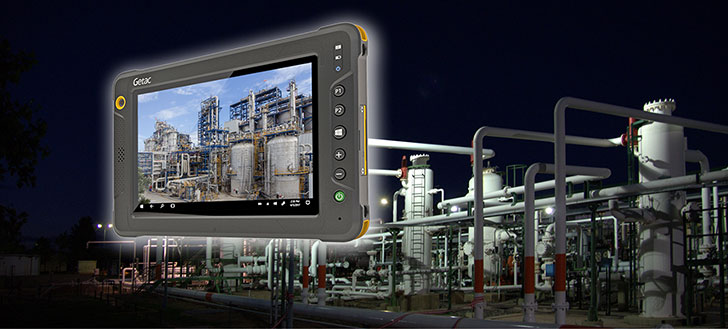
|
|
|
GETAC EX80
HazLoc ATEX / IECEx Zone 0 and C1D1-certified, designed-from-the-ground-up, quad-core powered rugged Windows 10 tablet with sunlight readable glove-capable multi-touch display
(by Conrad H. Blickenstorfer)
Share on:




On November 7, 2017, Getac announced its first-ever Class 1 Division 1 intrinsically safe device, the rugged 8-inch Windows 10-based EX80 tablet. We'll get into intrinsic safety terminology later in this article, but in essence this means that the Getac EX80 can be safely used in hazardous locations with potentially explosive atmospheres as are found in many oil & gas, petrochemical, and manufacturing locations.
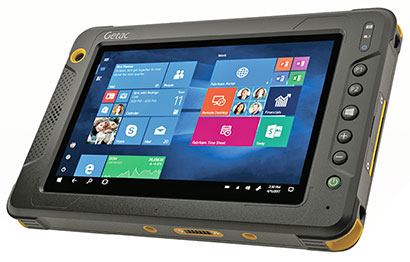
The term "hazardous location" — or "HazLoc" — stems from electrical engineering where a hazardous location is  defined as a place where concentrations of flammable gases, vapors, dusts or fibers occur.
defined as a place where concentrations of flammable gases, vapors, dusts or fibers occur.
Electrical equipment cleared for use in such environments must be designed so that it cannot inadvertently ignite potentially explosive matters. Devices that comply with a strict set of rules are considered "intrinsically safe."
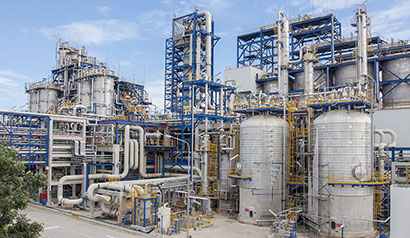
The challenges of intrinsic safety
What makes creating an intrinsically safe device a challenge is not only the work required in eliminating any conceivable potential for sparking and ignition, but also the very nature of "hazardous locations." Most locations that are considered hazardous are "tiered," i.e. some areas are safe and don't require special precautions whereas others are classified as hazardous to a lesser or greater extent. The hazardous areas fall into a different zones and classifications that require various degrees and certifications of electronic safety.
The illustration below shows an example of different zones at a typical gas station.
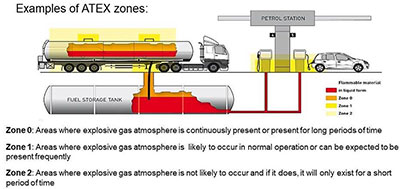
Employees often work in different such areas, even within the same building, which means their devices must be certified for use in different HazLoc zones. So what's needed is a handy, general purpose mobile computer that also so happens to be certified for use in whatever hazardous zones work is to be done.
A solid hardware platform
Intrinsic safety means elimination of all conceivable causes of ignition. This affects chassis design, thermal management, mechanical testing, charging, elimination of connectors where friction could cause sparking and more.
And whereas modularity is a plus in general purpose devices because it allows customization, intrinsic safety means all functionality must be part of the motherboard and popular options must be integrated into the design. Why? Because any change or customization would require re-certification.
So let's take a look at the technology in the EX80:
Every good tablet starts with a great display. The Getac EX80's "Lumibond 2.0" 8-inch screen has 1280 x 800 pixel resolution (that's 186 pixels per inch, about the same sharpness as a Dell UltraSharp 4k desktop monitor), uses capacitive multi-touch, and has a bright 600 nits backlight. It's an IPS LCD which brings near perfect viewing angles from all directions, as well as complete elimination of color and contrast shifts. There's 2mm tempered glass that won't even crack or shatter when a 2.2 -pound steel ball is dropped on it from 8 inches. There's glove-capable capacitive multi-touch, a for extra precision a nice 3.5mm hard tip stylus.
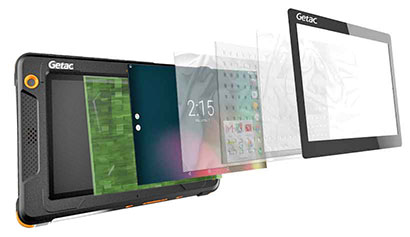
The processor must be sufficient for the job. Here, Getac picked a quad-core Intel "Cherry Trail" Atom X5-Z8350 running at 1.44GHz. The chip — which is based on 14nm process technology and can reach burst frequencies of up to 1.92GHz. This is mid-range Intel Atom chip and frequently used in fanless tablets. RAM and storage is fixed; customers get 4GB of LPDDR3 RAM and 128GB of eMMC solid state storage.
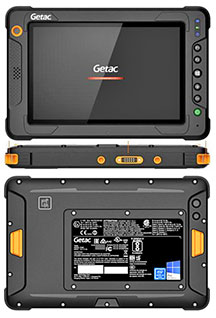 The EX80 has a foot print of 9.4 x 6.1 inches, is an inch and an eight thick, and weighs 3.25 pounds. According to Getac, the unit's 31.1 watt-hour Li-Ion battery provides over 8.5 hours between charges. The EX80 has a foot print of 9.4 x 6.1 inches, is an inch and an eight thick, and weighs 3.25 pounds. According to Getac, the unit's 31.1 watt-hour Li-Ion battery provides over 8.5 hours between charges.
As far as communications capabilities go, there's dual band 802.11a/b/g/n WiFi, Bluetooth v4.0, HF RFID/NFC, dual cameras, and discrete GPS. This is all standard. 4G LTE WWAN is also available.
Don't look for access panels. Intrinsically safe systems must be totally closed and sealed. Even the 20 or so screws that hold the housing together are of an unusual format so as to discourage taking the unit apart. Makes sense.
Intrinsically safe design
Intrinsically safe design means various departures from standard electronics design practices. Among those departures are:
- Stricter surface temperature control to preclude ignition (sensors, cooling),
- A safe charging process (no standard power jack that could spark),
- Double fault circuit design (voltage control),
- Electronics potting (enclosing them in special curable liquids),
- Anti-static materials,
- Extensive thermal and impact testing.
Since the EX80 doesn't have a power jack, charging is via pogo surface mount contacts with an included cradle in a non-explosive environment. A hot-swappable battery would have been nice, as would have some sort of add-on module system (like the HART industrial automation protocol). That, however, would have added size, weight and cost.
Substantial ruggedness
On the ruggedness side, the EX80 can handle 6-foot drops, has a very wide operating temperature range of -6° to +122° degrees Fahrenheit (-21°C to +50° Celsius), and carries IP67 sealing, where the "6" stands for protection against full immersion down to about three feet for 30 minutes. Getac claims extensive military grade MIL-STD-810G testing, including salt fog, altitude, vibration, shock, humidity, etc.
OS and security
The Getac EX80 runs Windows 10 Professional. And that includes access to all of Windows 10's advanced security features. There's also TPM 2.0, a contactless SmartCard reader, and optional Absolute DDS software.
Summary: Getac EX80
With the ATEX / IECEx Zone 0 and C1D1-certified EX80, Getac offers a special type of tablet for work in hazardous locations that strictly mandate the use of intrinsically safe equipment. The EX80 fills these requirements in a handy, contemporary and very rugged 8-inch Windows tablet that's small and light enough to go anywhere.
-- C. H. Blickenstorfer, November 2017
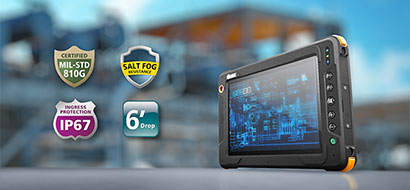
|
|
|
 Specifications Getac EX80 Specifications Getac EX80
|
|
Added/updated
|
Added 11/2017
|
|
Form-factor
|
Rugged C1D1 tablet
|
|
OS
|
Windows 10 Professional
|
|
Processor
|
Quad-core Intel Atom X5-Z8350
|
CPU Speed/Turbo
|
1.44GHz/1.92GHz
|
Graphics
|
Intel HD Graphics 400
|
Standard/Max RAM
|
4GB LPDDR3
|
Disk/drive
|
128GB eMMC
|
Card slots
|
NA
|
Display type
|
"LumiBond 2.0" sunlight-readable IPS TFT LCD, 600 nits luminance, 170° viewing angle, 2mm tempered glass
|
Display size/res
|
8.0-inch/1280 x 720 pixel (184 ppi)
|
Digitizer/pens
|
Capacitive multi-touch (hard tip stylus), glove-capable
|
Keyboard/scale
|
Onscreen
|
Navigation/operation
|
Touch, buttons (power, Windows, Volume up/down, 2 x programmable)
|
Sealing
|
IP67 (30 minute immersion at 1 meter
|
Shock
|
MIL-STD-810G: 6-foot drop
|
Salt-fog
|
MIL-STD-810G 509.5
|
Altitude
|
MIL-STD-810G Method 500.5 Procedure I&II
|
Vibration
|
MIL-STD-810G Method 514.6 Procedure I
|
Impact test
|
1kg steel ball drop resistance: 40cm on enclosure, 20cm on display and lenses
|
Operating temperature
|
-6°F to +122°F (-21°C to +50°C)
|
Thermal endurance
|
+60°C and 90% relative humidity for 28 days, -35°C for 1 day
|
Humidity
|
95% relative humidity, non-condensing
|
Ex protection
|
ATEX/IECEX:
EX II 1 GD
Gas: Ex ia op is IIC T4 Ga
Dust: Ex ia op is IIIC T135°C Da
UL913 (Intrinsically safe gear for use in Class I, II, and III, Division 1, hazardous locations):
NEC500 (Gas):
Class I, Div 1, Groups ABCD
NEC500 (Dust):
Class II, Div 1, Groups EFG
NEC500 (Fibers):
Class III, Div 1
NEC505 (Gas):
Class I, Zone 0, AEx ia Op IIC T4 Ga
NEC505 (Dust):
Class II, Zone 20, AEx ia IIIC T135°C Da
|
Housing
|
PolyCarbonate plastics and anti-static low-resistance rubber |
Size (WxHxD)
|
9.4 x 6.1 x 1.14 inches (240 x 155 x 29 mm)
|
Weight
|
3.26 lbs. (1.48 kg) with battery
|
Power
|
7.4V 4,200mAH 31.1 watt-hour Li-Ion "up to 8 hours", safe charging (no jack; charging dock)
|
Interface
|
24-pin docking port
|
Cameras
|
1 front (FHD), 1 rear (8mp AF with LED flash)
|
Sensors
|
e-compass, g-sensor
|
Security
|
TPM 2.0, contactless Smartcard reader, optional Absolute DDS
|
Communications
|
802.11a/b/g/n WiFi, Bluetooth 4.0, HF RFID reader, dedicated GPS; optional 4G LTE multi-carrier WWAN
|
List price
|
Inquire
|
Warranty
|
3-year "bumper-to-bumper" warranty standard
|
Press release
|
Getac EX80 press release
|
Spec sheet
|
Getac EX80 brochure
|
Website
|
EX80 on Getac web
|
|
 Intrinsic Safety Intrinsic Safety
|
|
The term "hazardous location" — or "HazLoc" — originates from electrical engineering where a hazardous location is defined as a place where concentrations of flammable gases, vapors, or dusts occur. Electrical equipment operating in such areas must be designed so that they do not cause combustion or explosions. Devices that fulfill that requirement are described as "intrinsically safe," which means that they are incapable of igniting such gasses, dust or vapors.
As one might expect, there are degrees of intrinsic safety, and there are many different classification systems for various hazardous substances, as well as for the degree of the presence of such substances.
For the classification of rugged computing equipment, manufacturers generally use the:
- North American National Electric Code (NEC)
- International IECEx directive
- European ATEX directive
The ATEX acronym stems from a French expression that includes ATmospheres EXplosives. How do those entities classify hazardous environments?
NEC first differentiates between
- Class 1 (Flammable gases)
- Class 2 (Flammable dust)
- Class 3 (Flammable fibers)
Each of the classes then is either
- Division 1 (substance present all the time), or
- Division 2 (substance present only for brief time).
A third level (Group) then describes the specific type of gas, dust or fibers.
IEC/ATEX, on the other hand, first differentiates between:
- Flammable gases and vapors ("G"), and
- Flammable dust ("D").
Flammable gases are then assigned:
- Zone 0 (always present)
- Zone 1 (likely present), and
- Zone 2 (occasionally present).
Flammable dust uses
- Zone 20 (always present)
- Zone 21 (likely present), and
- Zone 22 (occasionally present).
Each zone then requires equipment built for
- Category I (present continuously)
- Category II (present intermittently), and
- Category III (occasionally present).
To illustrate how these classification systems apply to real life situations, picture a gas station.
Using the NEC classification, underground gas tanks and tanker truck tanks are Class 1, Division 1; the area around a tanker truck or a gas pump would also be Class 1, Division 1; and the general gas station area is Class 1, Division 2.
Using the IEC/ATEX classification, underground gas tanks and tanker truck tanks are Zone 0, Category I; the area around a tanker truck or a gas pump would be Zone 1, Category I; and the general gas station area is Zone 2, Category 2.
Note that this is an oversimplification; both standards have several additional classification criteria such as temperature, explosion groups, protection levels, etc. (for additional info, check out this classification reference guide).
|
|
 Getac EX80 Getac EX80
|

|
 Getac
Getac
 us.getac.com
us.getac.com
 GetacSales_US@getac.com
GetacSales_US@getac.com
|
|
|
|












